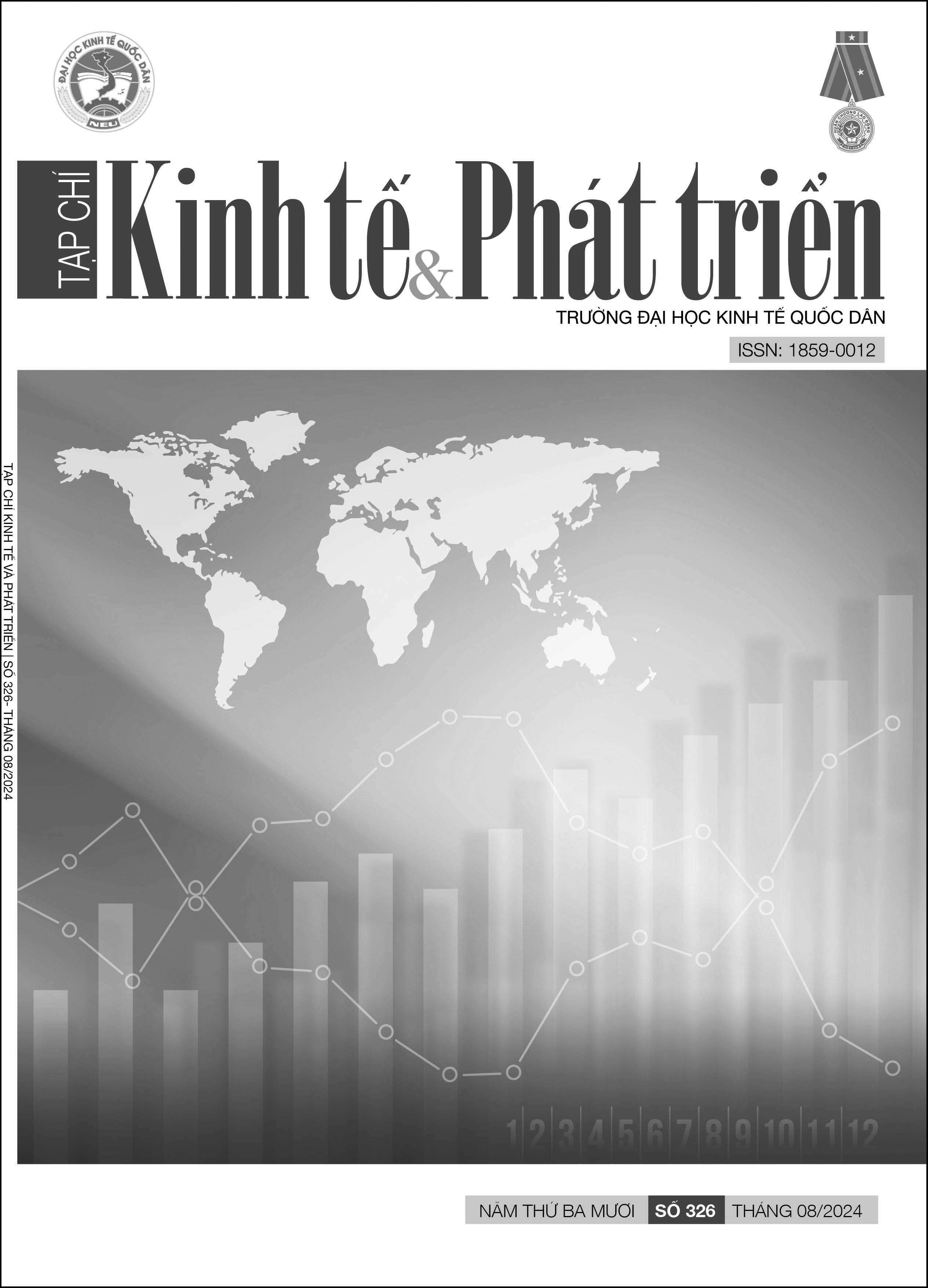Tác động của số hoá lên dòng kiều hối ở các quốc gia Châu Á đang phát triển
DOI:
https://doi.org/10.33301/JED.VI.1461Từ khóa:
Số hóa, dòng kiều hối, các quốc gia Châu Á đang phát triểnTóm tắt
Bài viết áp dụng số thuê bao băng thông cố định và tỷ lệ người dùng Internet là các biến số đại diện cho số hóa để kiểm tra ảnh hưởng của số hóa lên kiều hối cho bộ dữ liệu bảng của 30 nền kinh tế đang phát triển ở Châu Á trong giai đoạn từ 2002 đến 2022 thông qua phương pháp ước lượng GMM sai phân hai bước. Kết quả nghiên cứu khẳng định số hóa làm thúc đẩy kiều hối ở các nền kinh tế này. Ngoài ra, độ mở thương mại và cơ sở hạ tầng cũng thúc đẩy kiều hối, trong khi tăng trưởng kinh tế và lạm phát lại làm giảm kiều hối. Các phát hiện này là cơ sở đề xuất một số chính sách cho chính phủ ở các nền kinh tế đang phát triển ở Châu Á về chương trình phát triển công nghệ số nhằm thu hút nhiều dòng kiều hối từ di dân và người lao động ở nước ngoài nhiều hơn.
Tài liệu tham khảo
Aggarwal, R., Demirgüç-Kunt, A., & Pería, M. S. M. (2011), ‘Do remittances promote financial development?’, Journal of Development Economics, 96(2), 255-264.
Akçay, S., & Karasoy, A. (2019), ‘Determinants of remittances in Egypt: Do macroeconomic instability and oil price matter?’, International Migration, 57(5), 142-160.
Arellano, M., & Bond, S. (1991), ‘Some tests of specification for panel data: Monte Carlo evidence and an application to employment equations’, The Review of Economic Studies, 58(2), 277-297.
Aydas, O. T., Metin-Ozcan, K., & Neyapti, B. (2005), ‘Determinants of workers' remittances: the case of Turkey’, Emerging Markets Finance and Trade, 41(3), 53-69.
Buch, C. M., & Kuckulenz, A. (2010), ‘Worker remittances and capital flows to developing countries’, International Migration, 48(5), 89-117.
Castillo‐Ponce, R. A., Hugo Torres‐Preciado, V., & Luis Manzanares‐Rivera, J. (2011), ‘Macroeconomic determinants of remittances for a dollarized economy: the case of El Salvador’, Journal of Economic Studies, 38(5), 562-576.
Chami, R., Fullenkamp, C., & Jahjah, S. (2005), ‘Are immigrant remittance flows a source of capital for development?’, IMF Staff Papers, 52(1), 55-81.
Coppola, D. (2006), Introduction to international disaster management, Elsevier.
Emara, N., & Zhang, Y. (2021), ‘The non-linear impact of digitization on remittances inflow: Evidence from the BRICS’, Telecommunications Policy, 45(4). DOI: https://doi.org/10.1016/j.telpol.2021.102112.
Engbersen, G., & Dekker, R. (2014), ‘How social media transform migrant networks and facilitate migration’, Global Networks, 4(64), 1–19.
Gascón, P., Larramona, G., & Salvador, M. (2023), ‘The impact of digitalisation on remittances. Evidence from El Salvador’, Telecommunications Policy, 47(4), 102500. DOI: https://doi.org/10.1016/j.telpol.2023.102500.
Holtz-Eakin, D., Newey, W., & Rosen, H. S. (1988), ‘Estimating vector autoregressions with panel data’, Econometrica, 56(6), 1371-1395.
Jijin, P., Mishra, A. K., & Nithin, M. (2022), ‘Macroeconomic determinants of remittances to India’, Economic Change and Restructuring, 55(2), 1229-1248.
Jawaid, S. T., & Raza, S. A. (2016), ‘Effects of workers' remittances and its volatility on economic growth in South Asia’, International Migration, 54(2), 50-68.
Lartey, E. K., & Mengova, E. (2016), ‘Does institutional quality in developing countries affect remittances?’, The Journal of Developing Areas, 50(1), 59-76.
Luca, A., & Petrova, I. (2008), ‘What drives credit dollarization in transition economies?’, Journal of Banking & Finance, 32(5), 858-869.
Lyons, A. C., Kass-Hanna, J., & Fava, A. (2022), ‘Fintech development and savings, borrowing, and remittances: A comparative study of emerging economies’, Emerging Markets Review, 51, 100842. DOI: https://doi.org/10.1016/j.ememar.2021.100842.
Polat, B., & Rodríguez Andrés, A. (2019), ‘Do emigrants’ remittances cause Dutch disease? A developing countries case study’, The Economic and Labour Relations Review, 30(1), 59-76.
Ratha, D. (2003), Workers’ Remittances: An Important and Stable Source of External Development Finance, Global Development Finance, World Bank, Washington DC.
Ratha, D., & Shaw, W. (2007), ‘South-South migration and remittances’, World Bank Working Paper, 102, 1–10. DOI: https://doi.org/10.17848/9781429492072.ch1.
Rodima-Taylor, D., & Grimes, W. (2019), ‘International remittance rails as infrastructures: Embeddedness, innovation and financial access in developing economies’, Review of International Political Economy, 26(5), 839–862. DOI: https://doi.org/10.1080/09692290.2019.1607766.
Roodman, D. (2009), ‘How to do xtabond2: An introduction to difference and system GMM in Stata’, The Stata Journal, 9(1), 86-136.
Tabit, S., & Moussir, C.-E. (2016), ‘Macroeconomic determinants of migrants’ remittances: Evidence from a panel of developing countries’, International Journal of Business and Social Research, 6(7). DOI: https://doi.org/10.18533/ijbsr.v6i7.969.
Withaeckx, S., Schrooten, M., & Geldof, D. (2015), ‘Living across borders: The everyday experiences of Moroccan and Brazilian transmigrants in Belgium’, Crossings: Journal of Migration & Culture, 6(1), 23–40. DOI: https://doi.org/10.1386/cjmc.6.1.23_1.
Yoshino, N., Taghizadeh-Hesary, F., & Otsuka, M. (2020), ‘Determinants of international remittance inflow in Asia-Pacific middle-income countries’, Economic Analysis and Policy, 68, 29-43.





